WRIT 220: Wireless Battery Charger - Problems, Solutions, and Analysis
VerifiedAdded on 2023/01/20
|12
|2212
|42
Report
AI Summary
This report provides a detailed analysis of wireless battery charger technology, focusing on the problems encountered and proposing potential solutions. The report begins with an introduction highlighting the significance of wireless charging in the 21st century, followed by an examination of the problems associated with wired chargers. It then delves into the technical aspects of wireless charging, including the use of inductive coupling and electromagnetic fields. The core of the report identifies and discusses key challenges, such as limited charging range, complex internal circuitry, and signal losses. The report then proposes solutions, including improving charging frequency and simplifying circuit design. Furthermore, the report compares wireless chargers to wired chargers, highlighting advantages such as reduced wear and tear and enhanced device security. The report concludes by emphasizing the importance of further advancements in wireless charging technology and its potential applications.
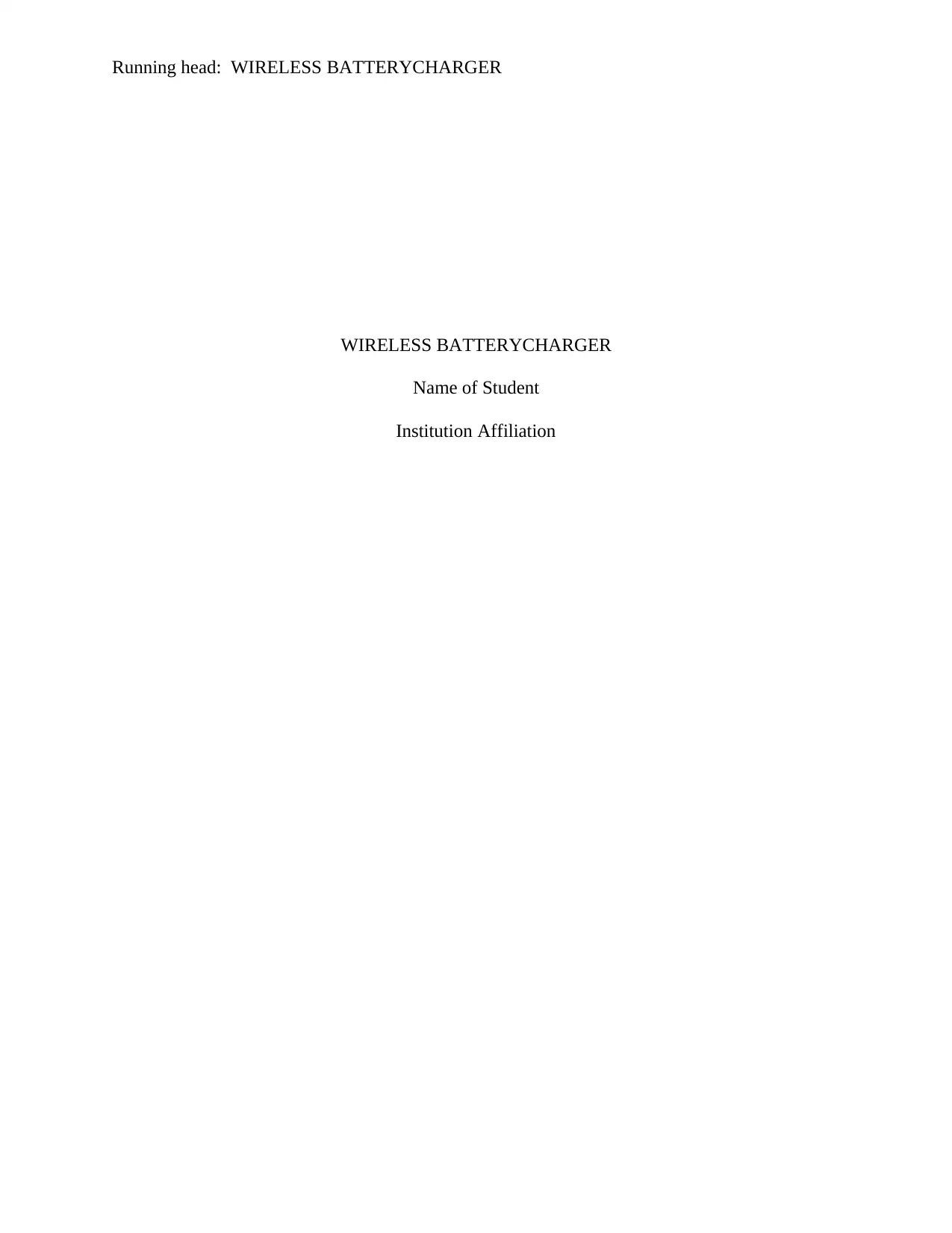
Running head: WIRELESS BATTERYCHARGER
WIRELESS BATTERYCHARGER
Name of Student
Institution Affiliation
WIRELESS BATTERYCHARGER
Name of Student
Institution Affiliation
Paraphrase This Document
Need a fresh take? Get an instant paraphrase of this document with our AI Paraphraser
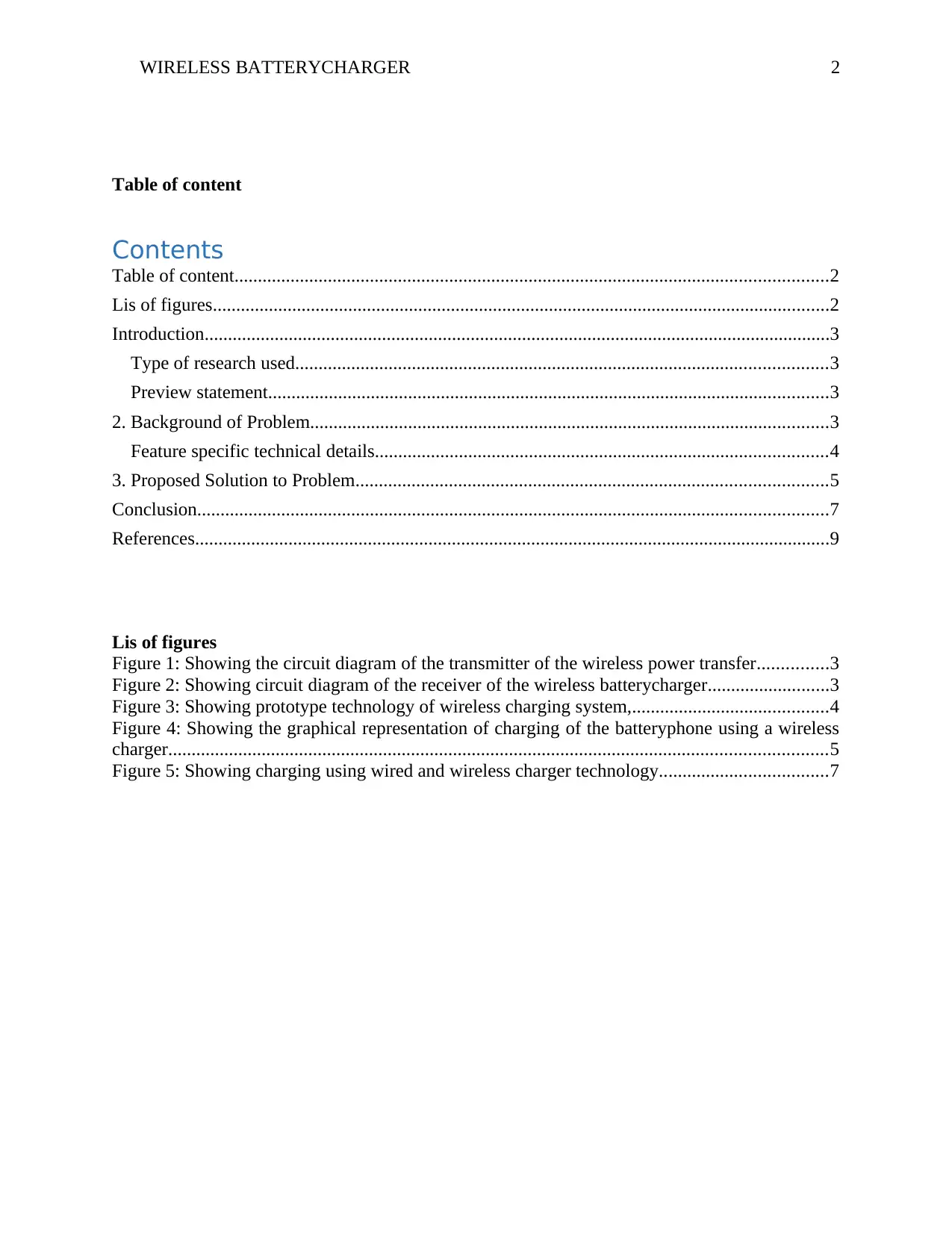
WIRELESS BATTERYCHARGER 2
Table of content
Contents
Table of content...............................................................................................................................2
Lis of figures....................................................................................................................................2
Introduction......................................................................................................................................3
Type of research used..................................................................................................................3
Preview statement........................................................................................................................3
2. Background of Problem...............................................................................................................3
Feature specific technical details.................................................................................................4
3. Proposed Solution to Problem.....................................................................................................5
Conclusion.......................................................................................................................................7
References........................................................................................................................................9
Lis of figures
Figure 1: Showing the circuit diagram of the transmitter of the wireless power transfer...............3
Figure 2: Showing circuit diagram of the receiver of the wireless batterycharger..........................3
Figure 3: Showing prototype technology of wireless charging system,..........................................4
Figure 4: Showing the graphical representation of charging of the batteryphone using a wireless
charger.............................................................................................................................................5
Figure 5: Showing charging using wired and wireless charger technology....................................7
Table of content
Contents
Table of content...............................................................................................................................2
Lis of figures....................................................................................................................................2
Introduction......................................................................................................................................3
Type of research used..................................................................................................................3
Preview statement........................................................................................................................3
2. Background of Problem...............................................................................................................3
Feature specific technical details.................................................................................................4
3. Proposed Solution to Problem.....................................................................................................5
Conclusion.......................................................................................................................................7
References........................................................................................................................................9
Lis of figures
Figure 1: Showing the circuit diagram of the transmitter of the wireless power transfer...............3
Figure 2: Showing circuit diagram of the receiver of the wireless batterycharger..........................3
Figure 3: Showing prototype technology of wireless charging system,..........................................4
Figure 4: Showing the graphical representation of charging of the batteryphone using a wireless
charger.............................................................................................................................................5
Figure 5: Showing charging using wired and wireless charger technology....................................7
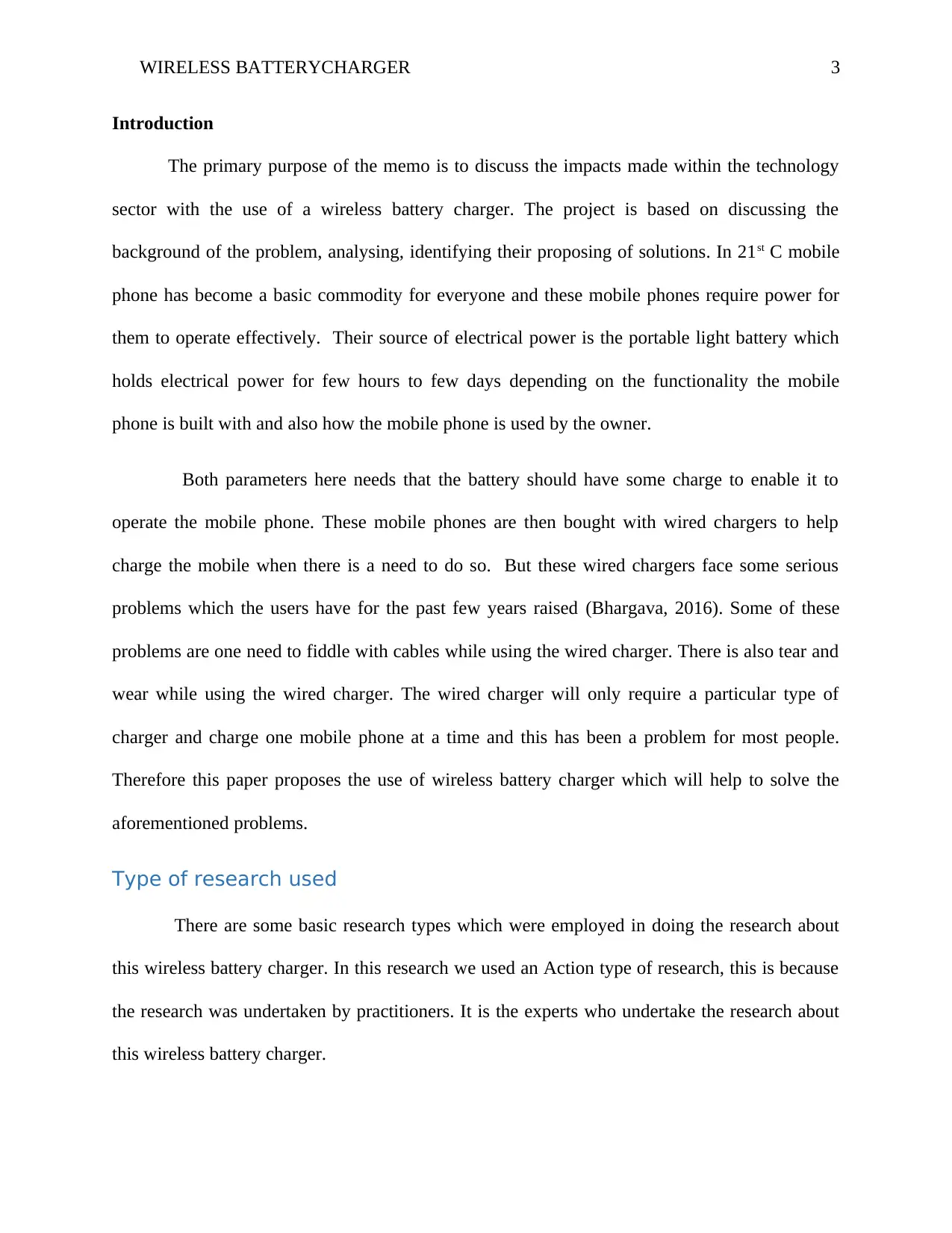
WIRELESS BATTERYCHARGER 3
Introduction
The primary purpose of the memo is to discuss the impacts made within the technology
sector with the use of a wireless battery charger. The project is based on discussing the
background of the problem, analysing, identifying their proposing of solutions. In 21st C mobile
phone has become a basic commodity for everyone and these mobile phones require power for
them to operate effectively. Their source of electrical power is the portable light battery which
holds electrical power for few hours to few days depending on the functionality the mobile
phone is built with and also how the mobile phone is used by the owner.
Both parameters here needs that the battery should have some charge to enable it to
operate the mobile phone. These mobile phones are then bought with wired chargers to help
charge the mobile when there is a need to do so. But these wired chargers face some serious
problems which the users have for the past few years raised (Bhargava, 2016). Some of these
problems are one need to fiddle with cables while using the wired charger. There is also tear and
wear while using the wired charger. The wired charger will only require a particular type of
charger and charge one mobile phone at a time and this has been a problem for most people.
Therefore this paper proposes the use of wireless battery charger which will help to solve the
aforementioned problems.
Type of research used
There are some basic research types which were employed in doing the research about
this wireless battery charger. In this research we used an Action type of research, this is because
the research was undertaken by practitioners. It is the experts who undertake the research about
this wireless battery charger.
Introduction
The primary purpose of the memo is to discuss the impacts made within the technology
sector with the use of a wireless battery charger. The project is based on discussing the
background of the problem, analysing, identifying their proposing of solutions. In 21st C mobile
phone has become a basic commodity for everyone and these mobile phones require power for
them to operate effectively. Their source of electrical power is the portable light battery which
holds electrical power for few hours to few days depending on the functionality the mobile
phone is built with and also how the mobile phone is used by the owner.
Both parameters here needs that the battery should have some charge to enable it to
operate the mobile phone. These mobile phones are then bought with wired chargers to help
charge the mobile when there is a need to do so. But these wired chargers face some serious
problems which the users have for the past few years raised (Bhargava, 2016). Some of these
problems are one need to fiddle with cables while using the wired charger. There is also tear and
wear while using the wired charger. The wired charger will only require a particular type of
charger and charge one mobile phone at a time and this has been a problem for most people.
Therefore this paper proposes the use of wireless battery charger which will help to solve the
aforementioned problems.
Type of research used
There are some basic research types which were employed in doing the research about
this wireless battery charger. In this research we used an Action type of research, this is because
the research was undertaken by practitioners. It is the experts who undertake the research about
this wireless battery charger.
⊘ This is a preview!⊘
Do you want full access?
Subscribe today to unlock all pages.

Trusted by 1+ million students worldwide
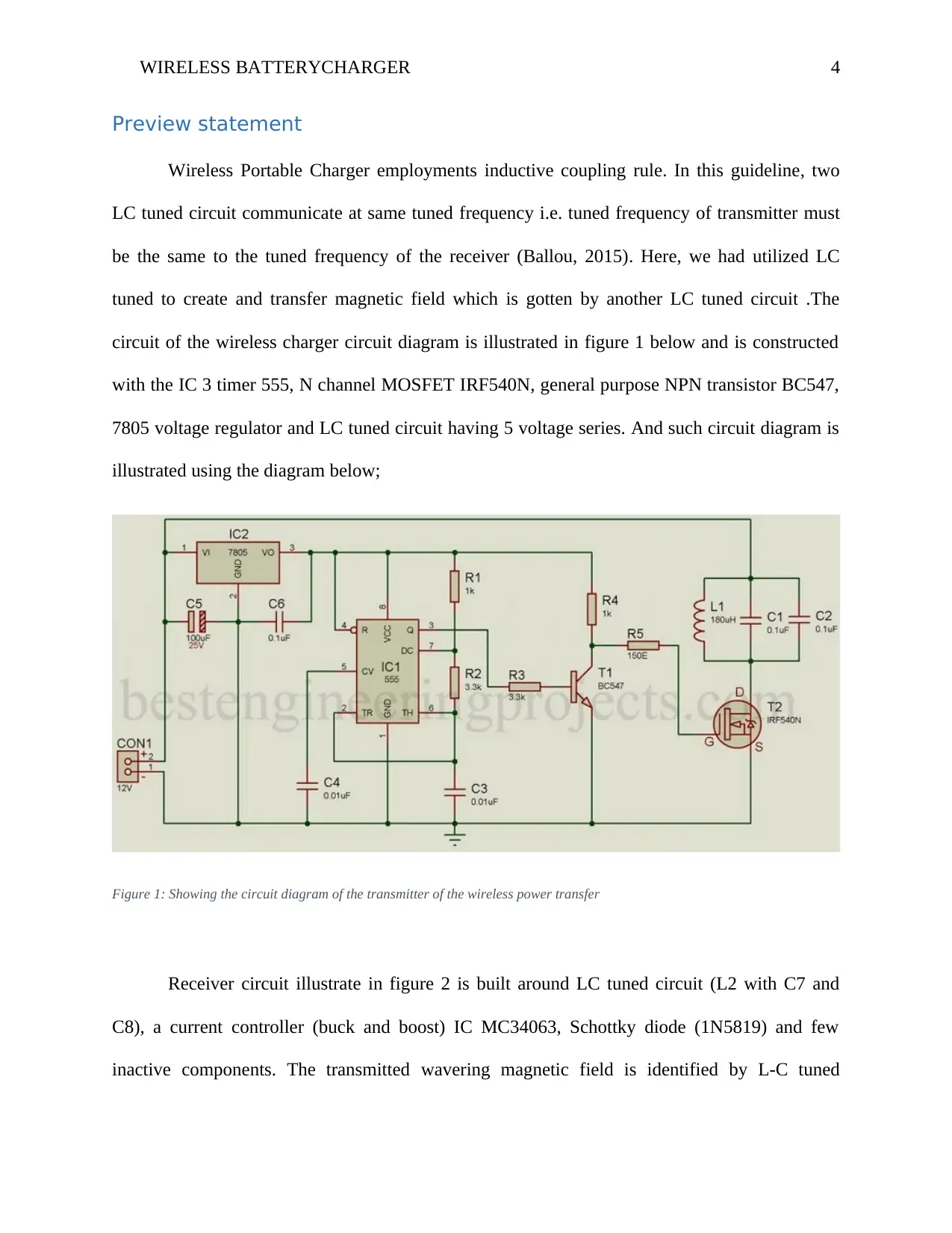
WIRELESS BATTERYCHARGER 4
Preview statement
Wireless Portable Charger employments inductive coupling rule. In this guideline, two
LC tuned circuit communicate at same tuned frequency i.e. tuned frequency of transmitter must
be the same to the tuned frequency of the receiver (Ballou, 2015). Here, we had utilized LC
tuned to create and transfer magnetic field which is gotten by another LC tuned circuit .The
circuit of the wireless charger circuit diagram is illustrated in figure 1 below and is constructed
with the IC 3 timer 555, N channel MOSFET IRF540N, general purpose NPN transistor BC547,
7805 voltage regulator and LC tuned circuit having 5 voltage series. And such circuit diagram is
illustrated using the diagram below;
Figure 1: Showing the circuit diagram of the transmitter of the wireless power transfer
Receiver circuit illustrate in figure 2 is built around LC tuned circuit (L2 with C7 and
C8), a current controller (buck and boost) IC MC34063, Schottky diode (1N5819) and few
inactive components. The transmitted wavering magnetic field is identified by L-C tuned
Preview statement
Wireless Portable Charger employments inductive coupling rule. In this guideline, two
LC tuned circuit communicate at same tuned frequency i.e. tuned frequency of transmitter must
be the same to the tuned frequency of the receiver (Ballou, 2015). Here, we had utilized LC
tuned to create and transfer magnetic field which is gotten by another LC tuned circuit .The
circuit of the wireless charger circuit diagram is illustrated in figure 1 below and is constructed
with the IC 3 timer 555, N channel MOSFET IRF540N, general purpose NPN transistor BC547,
7805 voltage regulator and LC tuned circuit having 5 voltage series. And such circuit diagram is
illustrated using the diagram below;
Figure 1: Showing the circuit diagram of the transmitter of the wireless power transfer
Receiver circuit illustrate in figure 2 is built around LC tuned circuit (L2 with C7 and
C8), a current controller (buck and boost) IC MC34063, Schottky diode (1N5819) and few
inactive components. The transmitted wavering magnetic field is identified by L-C tuned
Paraphrase This Document
Need a fresh take? Get an instant paraphrase of this document with our AI Paraphraser
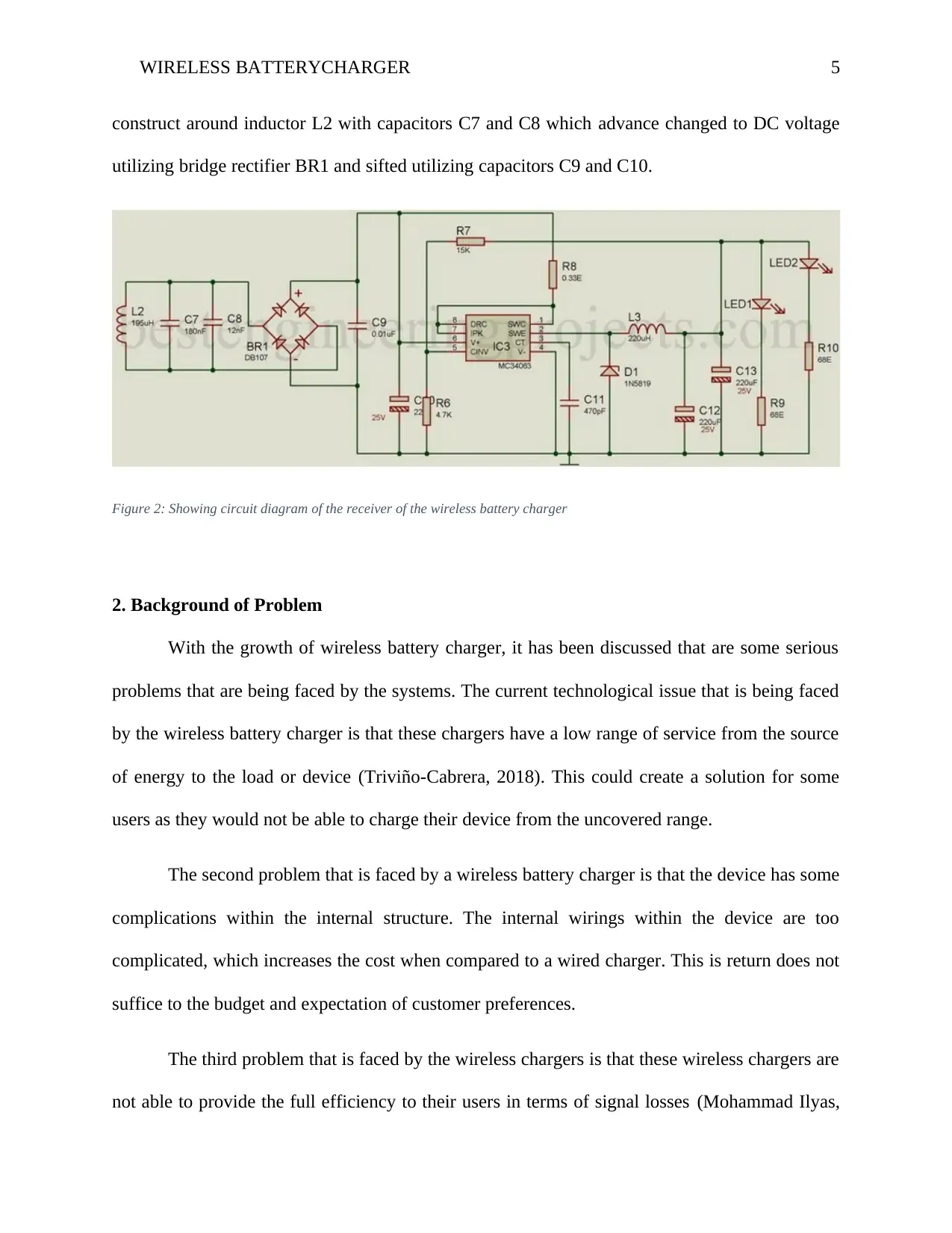
WIRELESS BATTERYCHARGER 5
construct around inductor L2 with capacitors C7 and C8 which advance changed to DC voltage
utilizing bridge rectifier BR1 and sifted utilizing capacitors C9 and C10.
Figure 2: Showing circuit diagram of the receiver of the wireless battery charger
2. Background of Problem
With the growth of wireless battery charger, it has been discussed that are some serious
problems that are being faced by the systems. The current technological issue that is being faced
by the wireless battery charger is that these chargers have a low range of service from the source
of energy to the load or device (Triviño-Cabrera, 2018). This could create a solution for some
users as they would not be able to charge their device from the uncovered range.
The second problem that is faced by a wireless battery charger is that the device has some
complications within the internal structure. The internal wirings within the device are too
complicated, which increases the cost when compared to a wired charger. This is return does not
suffice to the budget and expectation of customer preferences.
The third problem that is faced by the wireless chargers is that these wireless chargers are
not able to provide the full efficiency to their users in terms of signal losses (Mohammad Ilyas,
construct around inductor L2 with capacitors C7 and C8 which advance changed to DC voltage
utilizing bridge rectifier BR1 and sifted utilizing capacitors C9 and C10.
Figure 2: Showing circuit diagram of the receiver of the wireless battery charger
2. Background of Problem
With the growth of wireless battery charger, it has been discussed that are some serious
problems that are being faced by the systems. The current technological issue that is being faced
by the wireless battery charger is that these chargers have a low range of service from the source
of energy to the load or device (Triviño-Cabrera, 2018). This could create a solution for some
users as they would not be able to charge their device from the uncovered range.
The second problem that is faced by a wireless battery charger is that the device has some
complications within the internal structure. The internal wirings within the device are too
complicated, which increases the cost when compared to a wired charger. This is return does not
suffice to the budget and expectation of customer preferences.
The third problem that is faced by the wireless chargers is that these wireless chargers are
not able to provide the full efficiency to their users in terms of signal losses (Mohammad Ilyas,
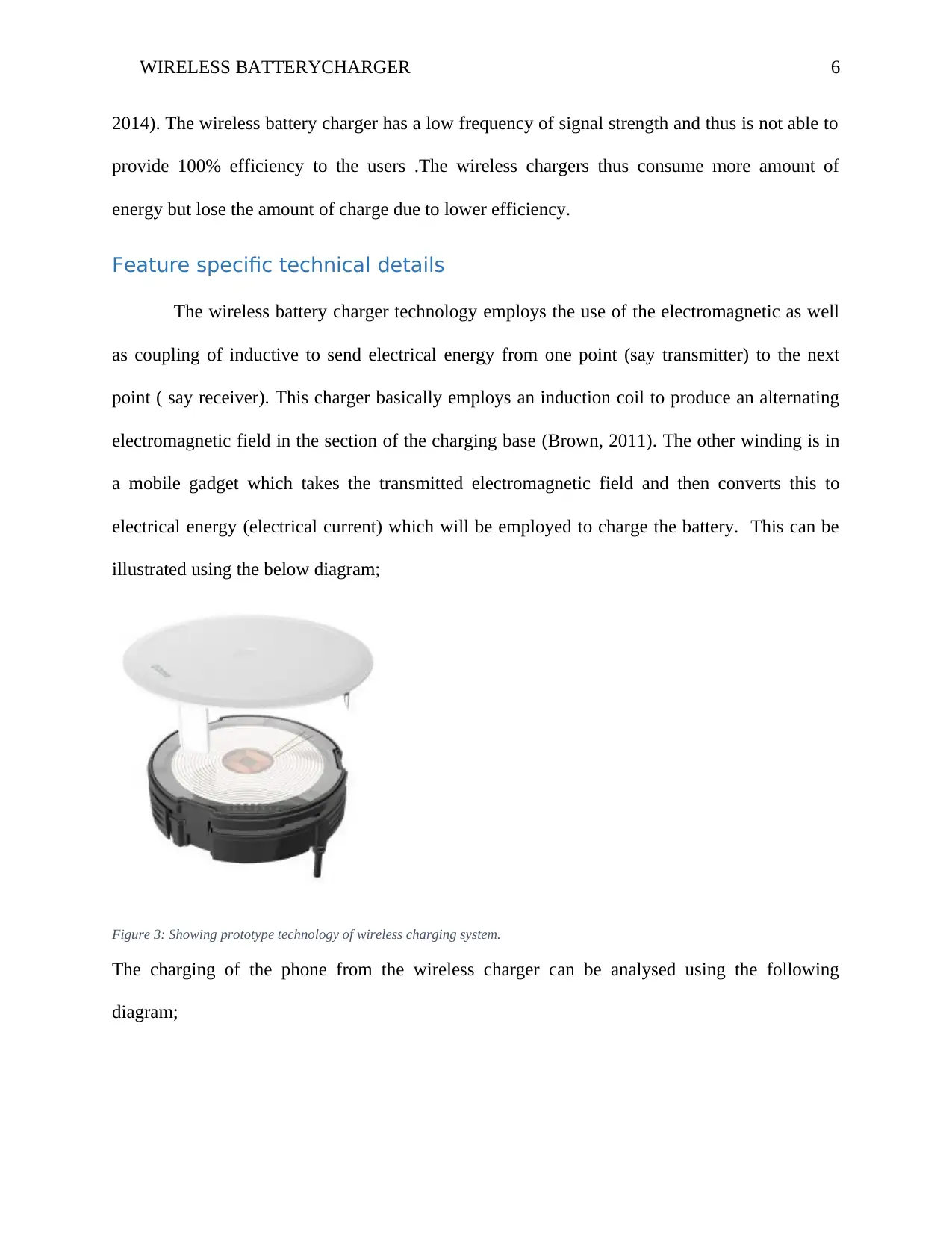
WIRELESS BATTERYCHARGER 6
2014). The wireless battery charger has a low frequency of signal strength and thus is not able to
provide 100% efficiency to the users .The wireless chargers thus consume more amount of
energy but lose the amount of charge due to lower efficiency.
Feature specific technical details
The wireless battery charger technology employs the use of the electromagnetic as well
as coupling of inductive to send electrical energy from one point (say transmitter) to the next
point ( say receiver). This charger basically employs an induction coil to produce an alternating
electromagnetic field in the section of the charging base (Brown, 2011). The other winding is in
a mobile gadget which takes the transmitted electromagnetic field and then converts this to
electrical energy (electrical current) which will be employed to charge the battery. This can be
illustrated using the below diagram;
Figure 3: Showing prototype technology of wireless charging system.
The charging of the phone from the wireless charger can be analysed using the following
diagram;
2014). The wireless battery charger has a low frequency of signal strength and thus is not able to
provide 100% efficiency to the users .The wireless chargers thus consume more amount of
energy but lose the amount of charge due to lower efficiency.
Feature specific technical details
The wireless battery charger technology employs the use of the electromagnetic as well
as coupling of inductive to send electrical energy from one point (say transmitter) to the next
point ( say receiver). This charger basically employs an induction coil to produce an alternating
electromagnetic field in the section of the charging base (Brown, 2011). The other winding is in
a mobile gadget which takes the transmitted electromagnetic field and then converts this to
electrical energy (electrical current) which will be employed to charge the battery. This can be
illustrated using the below diagram;
Figure 3: Showing prototype technology of wireless charging system.
The charging of the phone from the wireless charger can be analysed using the following
diagram;
⊘ This is a preview!⊘
Do you want full access?
Subscribe today to unlock all pages.

Trusted by 1+ million students worldwide
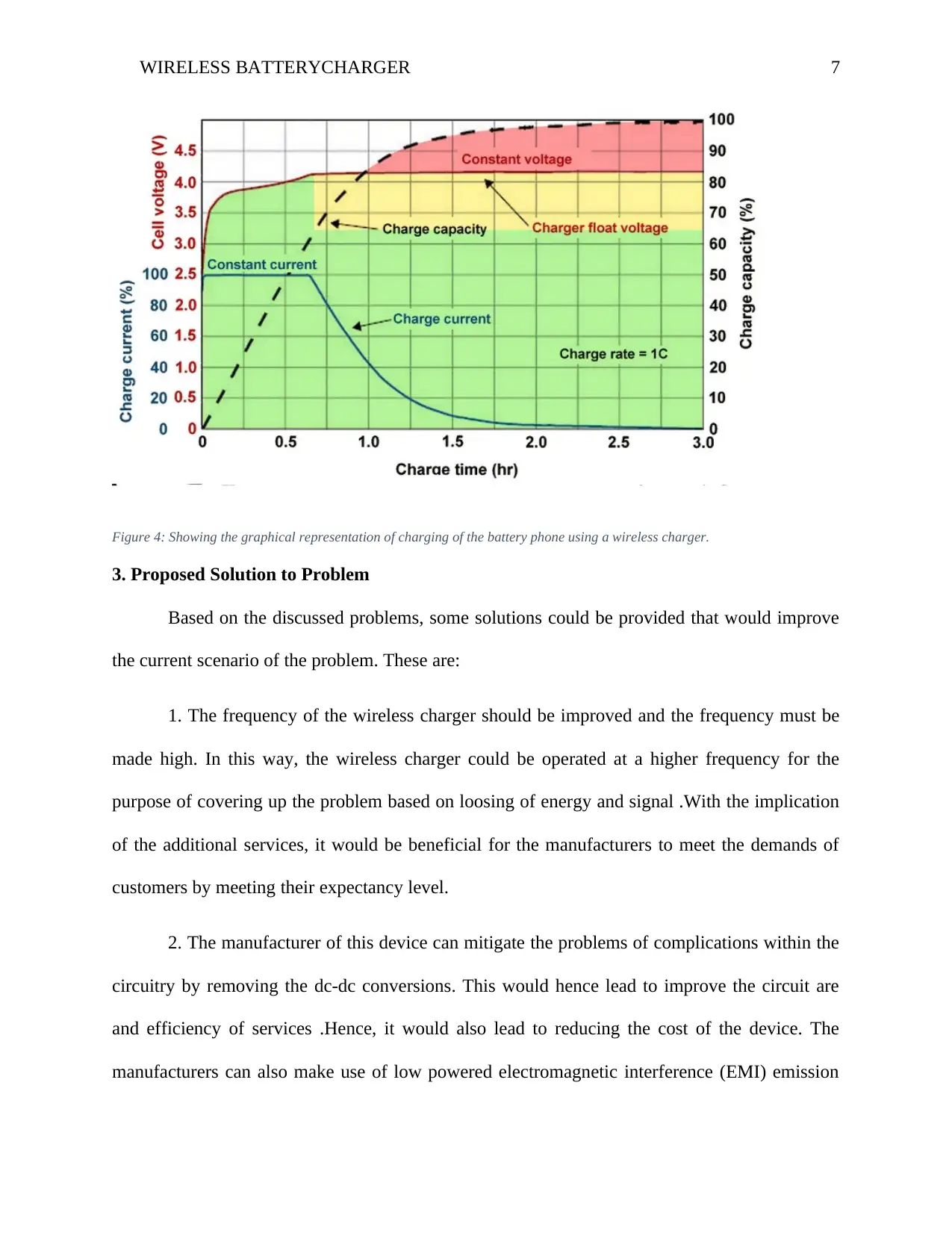
WIRELESS BATTERYCHARGER 7
Figure 4: Showing the graphical representation of charging of the battery phone using a wireless charger.
3. Proposed Solution to Problem
Based on the discussed problems, some solutions could be provided that would improve
the current scenario of the problem. These are:
1. The frequency of the wireless charger should be improved and the frequency must be
made high. In this way, the wireless charger could be operated at a higher frequency for the
purpose of covering up the problem based on loosing of energy and signal .With the implication
of the additional services, it would be beneficial for the manufacturers to meet the demands of
customers by meeting their expectancy level.
2. The manufacturer of this device can mitigate the problems of complications within the
circuitry by removing the dc-dc conversions. This would hence lead to improve the circuit are
and efficiency of services .Hence, it would also lead to reducing the cost of the device. The
manufacturers can also make use of low powered electromagnetic interference (EMI) emission
Figure 4: Showing the graphical representation of charging of the battery phone using a wireless charger.
3. Proposed Solution to Problem
Based on the discussed problems, some solutions could be provided that would improve
the current scenario of the problem. These are:
1. The frequency of the wireless charger should be improved and the frequency must be
made high. In this way, the wireless charger could be operated at a higher frequency for the
purpose of covering up the problem based on loosing of energy and signal .With the implication
of the additional services, it would be beneficial for the manufacturers to meet the demands of
customers by meeting their expectancy level.
2. The manufacturer of this device can mitigate the problems of complications within the
circuitry by removing the dc-dc conversions. This would hence lead to improve the circuit are
and efficiency of services .Hence, it would also lead to reducing the cost of the device. The
manufacturers can also make use of low powered electromagnetic interference (EMI) emission
Paraphrase This Document
Need a fresh take? Get an instant paraphrase of this document with our AI Paraphraser
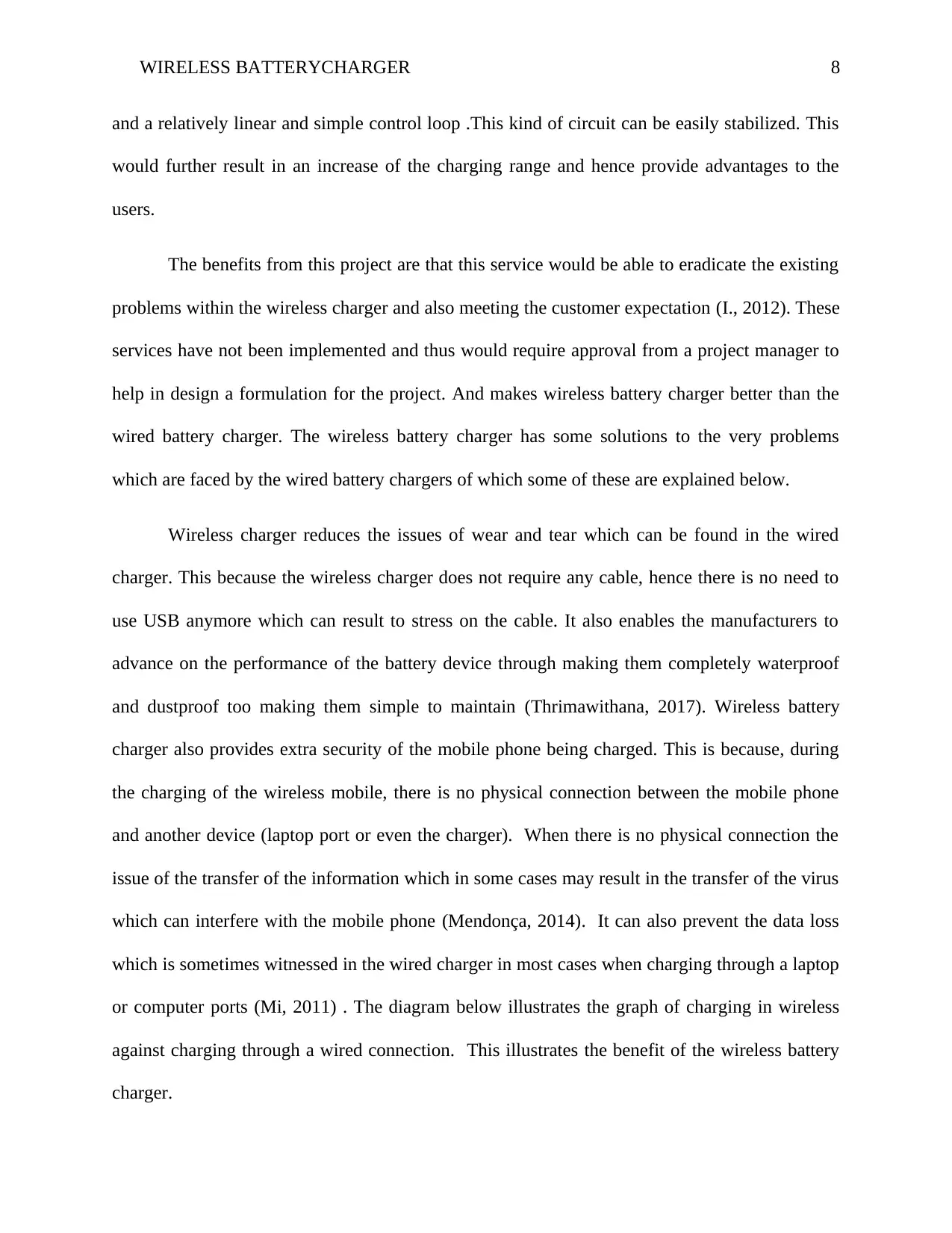
WIRELESS BATTERYCHARGER 8
and a relatively linear and simple control loop .This kind of circuit can be easily stabilized. This
would further result in an increase of the charging range and hence provide advantages to the
users.
The benefits from this project are that this service would be able to eradicate the existing
problems within the wireless charger and also meeting the customer expectation (I., 2012). These
services have not been implemented and thus would require approval from a project manager to
help in design a formulation for the project. And makes wireless battery charger better than the
wired battery charger. The wireless battery charger has some solutions to the very problems
which are faced by the wired battery chargers of which some of these are explained below.
Wireless charger reduces the issues of wear and tear which can be found in the wired
charger. This because the wireless charger does not require any cable, hence there is no need to
use USB anymore which can result to stress on the cable. It also enables the manufacturers to
advance on the performance of the battery device through making them completely waterproof
and dustproof too making them simple to maintain (Thrimawithana, 2017). Wireless battery
charger also provides extra security of the mobile phone being charged. This is because, during
the charging of the wireless mobile, there is no physical connection between the mobile phone
and another device (laptop port or even the charger). When there is no physical connection the
issue of the transfer of the information which in some cases may result in the transfer of the virus
which can interfere with the mobile phone (Mendonça, 2014). It can also prevent the data loss
which is sometimes witnessed in the wired charger in most cases when charging through a laptop
or computer ports (Mi, 2011) . The diagram below illustrates the graph of charging in wireless
against charging through a wired connection. This illustrates the benefit of the wireless battery
charger.
and a relatively linear and simple control loop .This kind of circuit can be easily stabilized. This
would further result in an increase of the charging range and hence provide advantages to the
users.
The benefits from this project are that this service would be able to eradicate the existing
problems within the wireless charger and also meeting the customer expectation (I., 2012). These
services have not been implemented and thus would require approval from a project manager to
help in design a formulation for the project. And makes wireless battery charger better than the
wired battery charger. The wireless battery charger has some solutions to the very problems
which are faced by the wired battery chargers of which some of these are explained below.
Wireless charger reduces the issues of wear and tear which can be found in the wired
charger. This because the wireless charger does not require any cable, hence there is no need to
use USB anymore which can result to stress on the cable. It also enables the manufacturers to
advance on the performance of the battery device through making them completely waterproof
and dustproof too making them simple to maintain (Thrimawithana, 2017). Wireless battery
charger also provides extra security of the mobile phone being charged. This is because, during
the charging of the wireless mobile, there is no physical connection between the mobile phone
and another device (laptop port or even the charger). When there is no physical connection the
issue of the transfer of the information which in some cases may result in the transfer of the virus
which can interfere with the mobile phone (Mendonça, 2014). It can also prevent the data loss
which is sometimes witnessed in the wired charger in most cases when charging through a laptop
or computer ports (Mi, 2011) . The diagram below illustrates the graph of charging in wireless
against charging through a wired connection. This illustrates the benefit of the wireless battery
charger.
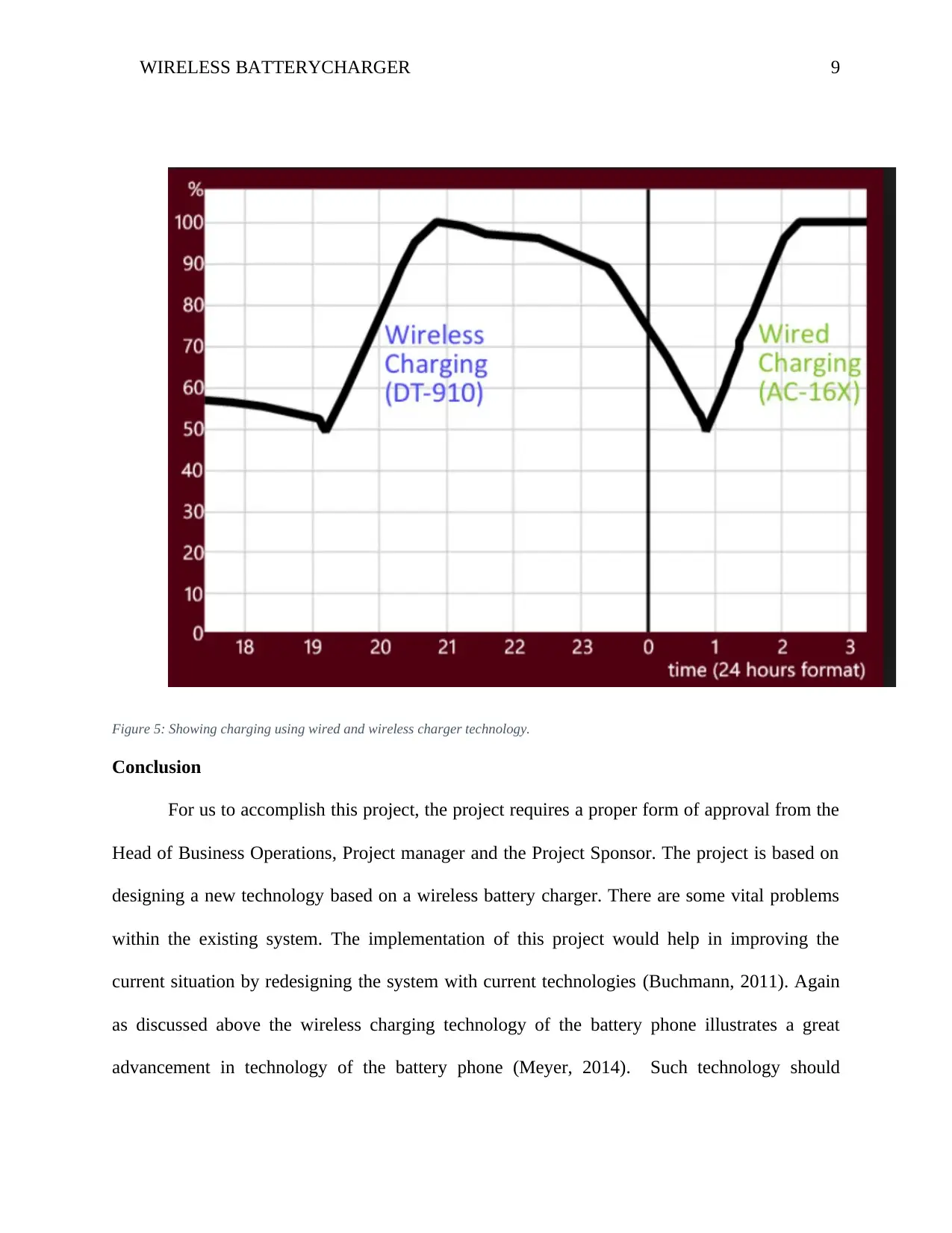
WIRELESS BATTERYCHARGER 9
Figure 5: Showing charging using wired and wireless charger technology.
Conclusion
For us to accomplish this project, the project requires a proper form of approval from the
Head of Business Operations, Project manager and the Project Sponsor. The project is based on
designing a new technology based on a wireless battery charger. There are some vital problems
within the existing system. The implementation of this project would help in improving the
current situation by redesigning the system with current technologies (Buchmann, 2011). Again
as discussed above the wireless charging technology of the battery phone illustrates a great
advancement in technology of the battery phone (Meyer, 2014). Such technology should
Figure 5: Showing charging using wired and wireless charger technology.
Conclusion
For us to accomplish this project, the project requires a proper form of approval from the
Head of Business Operations, Project manager and the Project Sponsor. The project is based on
designing a new technology based on a wireless battery charger. There are some vital problems
within the existing system. The implementation of this project would help in improving the
current situation by redesigning the system with current technologies (Buchmann, 2011). Again
as discussed above the wireless charging technology of the battery phone illustrates a great
advancement in technology of the battery phone (Meyer, 2014). Such technology should
⊘ This is a preview!⊘
Do you want full access?
Subscribe today to unlock all pages.

Trusted by 1+ million students worldwide
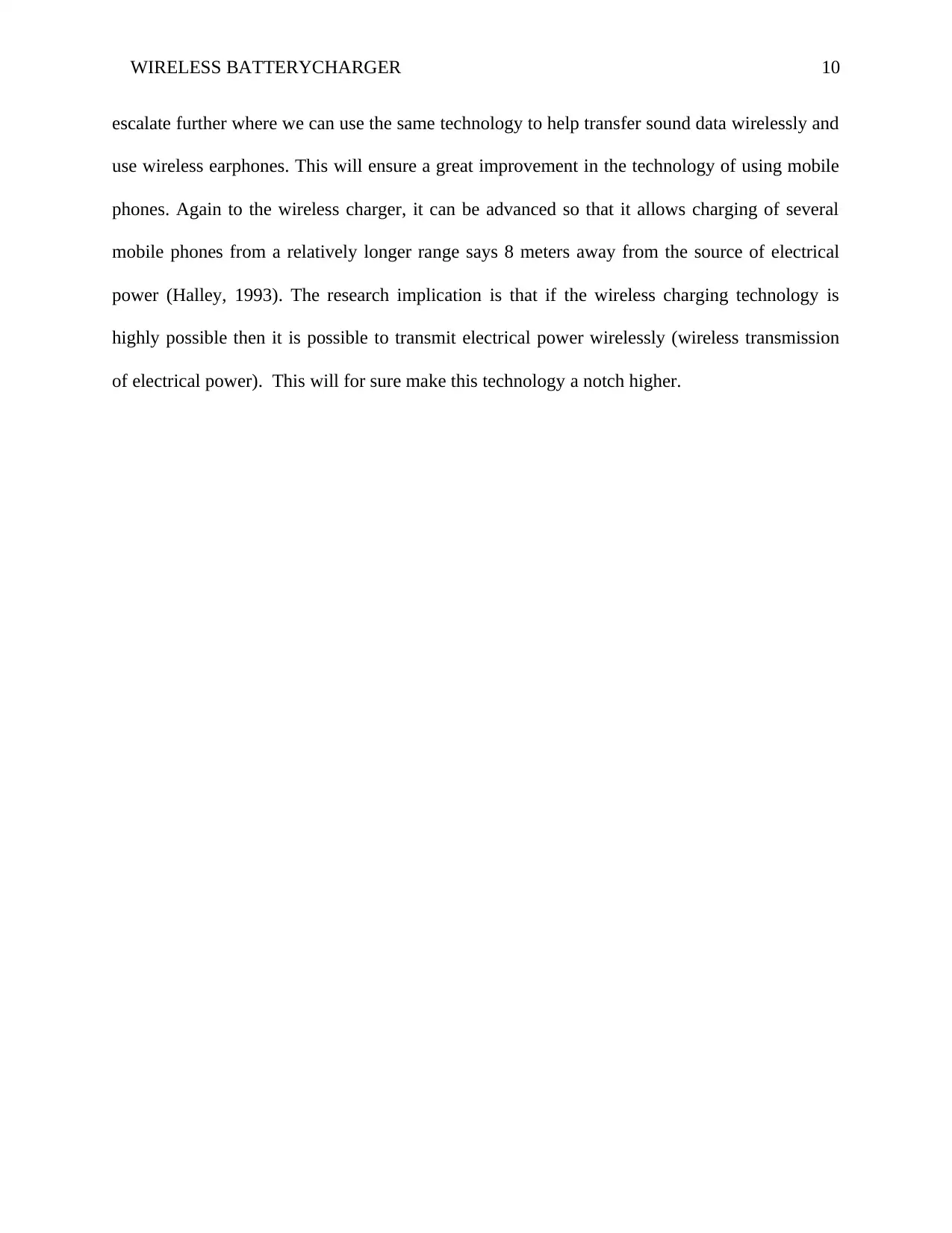
WIRELESS BATTERYCHARGER 10
escalate further where we can use the same technology to help transfer sound data wirelessly and
use wireless earphones. This will ensure a great improvement in the technology of using mobile
phones. Again to the wireless charger, it can be advanced so that it allows charging of several
mobile phones from a relatively longer range says 8 meters away from the source of electrical
power (Halley, 1993). The research implication is that if the wireless charging technology is
highly possible then it is possible to transmit electrical power wirelessly (wireless transmission
of electrical power). This will for sure make this technology a notch higher.
escalate further where we can use the same technology to help transfer sound data wirelessly and
use wireless earphones. This will ensure a great improvement in the technology of using mobile
phones. Again to the wireless charger, it can be advanced so that it allows charging of several
mobile phones from a relatively longer range says 8 meters away from the source of electrical
power (Halley, 1993). The research implication is that if the wireless charging technology is
highly possible then it is possible to transmit electrical power wirelessly (wireless transmission
of electrical power). This will for sure make this technology a notch higher.
Paraphrase This Document
Need a fresh take? Get an instant paraphrase of this document with our AI Paraphraser
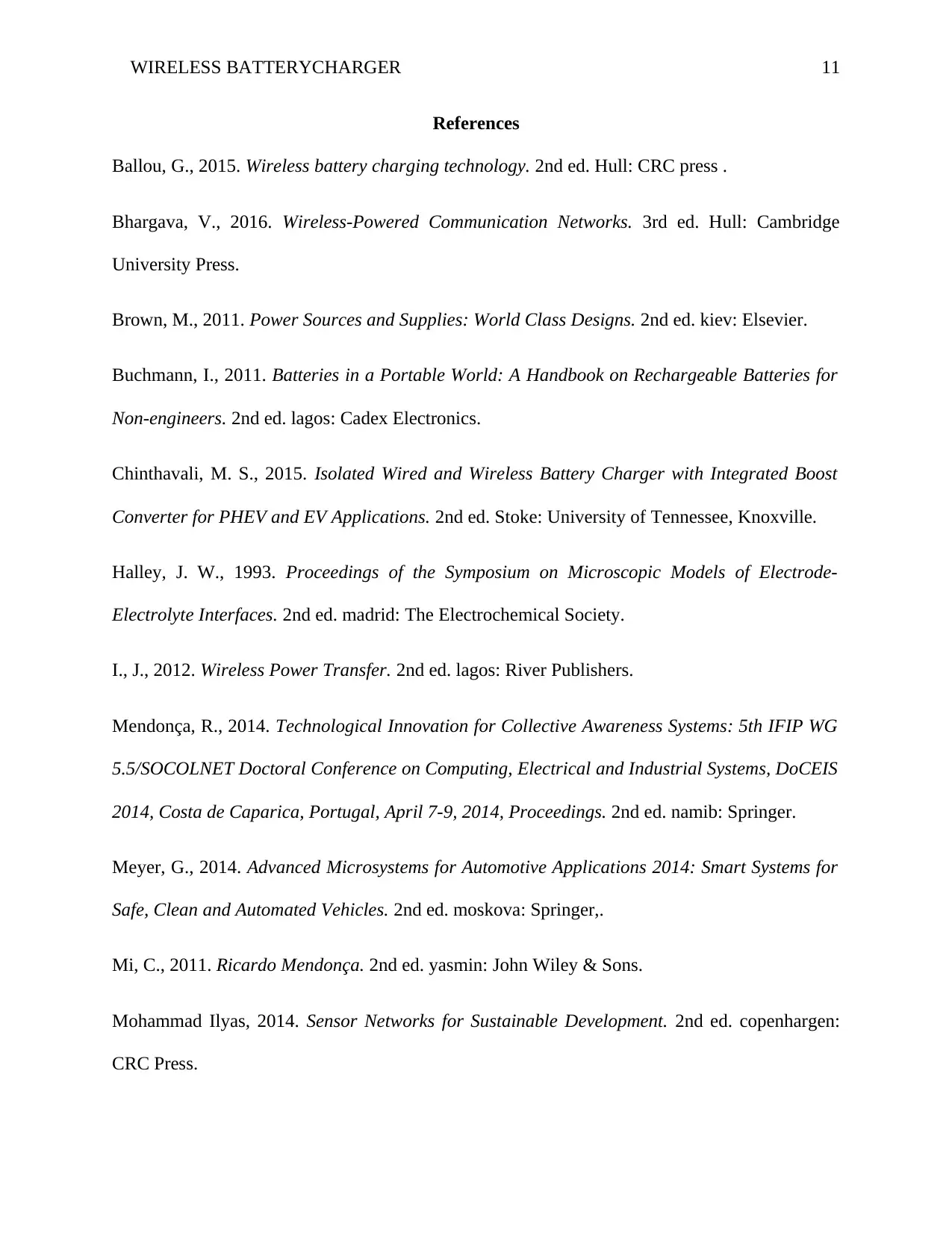
WIRELESS BATTERYCHARGER 11
References
Ballou, G., 2015. Wireless battery charging technology. 2nd ed. Hull: CRC press .
Bhargava, V., 2016. Wireless-Powered Communication Networks. 3rd ed. Hull: Cambridge
University Press.
Brown, M., 2011. Power Sources and Supplies: World Class Designs. 2nd ed. kiev: Elsevier.
Buchmann, I., 2011. Batteries in a Portable World: A Handbook on Rechargeable Batteries for
Non-engineers. 2nd ed. lagos: Cadex Electronics.
Chinthavali, M. S., 2015. Isolated Wired and Wireless Battery Charger with Integrated Boost
Converter for PHEV and EV Applications. 2nd ed. Stoke: University of Tennessee, Knoxville.
Halley, J. W., 1993. Proceedings of the Symposium on Microscopic Models of Electrode-
Electrolyte Interfaces. 2nd ed. madrid: The Electrochemical Society.
I., J., 2012. Wireless Power Transfer. 2nd ed. lagos: River Publishers.
Mendonça, R., 2014. Technological Innovation for Collective Awareness Systems: 5th IFIP WG
5.5/SOCOLNET Doctoral Conference on Computing, Electrical and Industrial Systems, DoCEIS
2014, Costa de Caparica, Portugal, April 7-9, 2014, Proceedings. 2nd ed. namib: Springer.
Meyer, G., 2014. Advanced Microsystems for Automotive Applications 2014: Smart Systems for
Safe, Clean and Automated Vehicles. 2nd ed. moskova: Springer,.
Mi, C., 2011. Ricardo Mendonça. 2nd ed. yasmin: John Wiley & Sons.
Mohammad Ilyas, 2014. Sensor Networks for Sustainable Development. 2nd ed. copenhargen:
CRC Press.
References
Ballou, G., 2015. Wireless battery charging technology. 2nd ed. Hull: CRC press .
Bhargava, V., 2016. Wireless-Powered Communication Networks. 3rd ed. Hull: Cambridge
University Press.
Brown, M., 2011. Power Sources and Supplies: World Class Designs. 2nd ed. kiev: Elsevier.
Buchmann, I., 2011. Batteries in a Portable World: A Handbook on Rechargeable Batteries for
Non-engineers. 2nd ed. lagos: Cadex Electronics.
Chinthavali, M. S., 2015. Isolated Wired and Wireless Battery Charger with Integrated Boost
Converter for PHEV and EV Applications. 2nd ed. Stoke: University of Tennessee, Knoxville.
Halley, J. W., 1993. Proceedings of the Symposium on Microscopic Models of Electrode-
Electrolyte Interfaces. 2nd ed. madrid: The Electrochemical Society.
I., J., 2012. Wireless Power Transfer. 2nd ed. lagos: River Publishers.
Mendonça, R., 2014. Technological Innovation for Collective Awareness Systems: 5th IFIP WG
5.5/SOCOLNET Doctoral Conference on Computing, Electrical and Industrial Systems, DoCEIS
2014, Costa de Caparica, Portugal, April 7-9, 2014, Proceedings. 2nd ed. namib: Springer.
Meyer, G., 2014. Advanced Microsystems for Automotive Applications 2014: Smart Systems for
Safe, Clean and Automated Vehicles. 2nd ed. moskova: Springer,.
Mi, C., 2011. Ricardo Mendonça. 2nd ed. yasmin: John Wiley & Sons.
Mohammad Ilyas, 2014. Sensor Networks for Sustainable Development. 2nd ed. copenhargen:
CRC Press.

WIRELESS BATTERYCHARGER 12
Thrimawithana, 2017. Inductive Power Transfer Systems: Theory, Modeling and Control. 2nd
ed. widhoek: Wiley,.
Triviño-Cabrera, 2018. Emerging Capabilities and Applications of Wireless Power Transfer. 2nd
ed. liverpool: IGI Global.
Thrimawithana, 2017. Inductive Power Transfer Systems: Theory, Modeling and Control. 2nd
ed. widhoek: Wiley,.
Triviño-Cabrera, 2018. Emerging Capabilities and Applications of Wireless Power Transfer. 2nd
ed. liverpool: IGI Global.
⊘ This is a preview!⊘
Do you want full access?
Subscribe today to unlock all pages.

Trusted by 1+ million students worldwide
1 out of 12
Related Documents
Your All-in-One AI-Powered Toolkit for Academic Success.
+13062052269
info@desklib.com
Available 24*7 on WhatsApp / Email
![[object Object]](/_next/static/media/star-bottom.7253800d.svg)
Unlock your academic potential
Copyright © 2020–2025 A2Z Services. All Rights Reserved. Developed and managed by ZUCOL.



